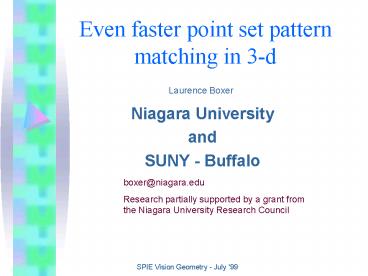Even faster point set pattern matching in 3-d - PowerPoint PPT Presentation
1 / 11
Title:
Even faster point set pattern matching in 3-d
Description:
2. Determine whether P is collinear. If so, handle via special (faster) algorithm for this case. If not, note a non-collinear triple T in P. ... – PowerPoint PPT presentation
Number of Views:59
Avg rating:3.0/5.0
Title: Even faster point set pattern matching in 3-d
1
Even faster point set pattern matching in 3-d
Laurence Boxer
- Niagara University
- and
- SUNY - Buffalo
boxer_at_niagara.edu Research partially supported by
a grant from the Niagara University Research
Council
2
The problem
Given a pattern set P and a sample set S in with
, identify all
subsets of S that are congruent to P.
3
History - 1
- P.J. de Rezende D.T. Lee, Point set pattern
matching in d dimensions, Algorithmica 13 (1995) - running time
4
History - 2
- L. Boxer, Point set pattern matching in 3-D,
Pattern Recognition Letters 17 (1996) - Running time
Key to improved running time derivation of
smaller upper bound on output, based on upper
bound for of segments of same length in S, due
to Clarkson, et al., Combinatorial complexity
bounds for arrangements of curves and surfaces,
Discrete Computational Geometry 5 (1990).
Output bound
5
Current paper
- Running time
Improved running time due to derivation of yet
smaller upper bound on output, from upper bound
on triangles in S, in T. Akutsu et al.,
Distributions of distances and triangles in a
point set and algorithms for computing the
largest common point sets, Discrete
Computational Geometry 20 (1998).
Output bound
6
Sketch of algorithm - 1
1. Sort S lexicographically.
2. Determine whether P is collinear. If so,
handle via special (faster) algorithm for this
case. If not, note a non-collinear triple T in P.
3. Find each triple T in S that matches T. Avoid
considering all triples by forming line segments,
sorting by length endpoints, searching.
- 4. For each T, compute the (at most constant
of) rigid transformations f such that f(T)T.
7
Sketch of algorithm - 2
- 5. For each rigid transformation f, compute the
set f(P\T) and for each of its members f(p),
determine by binary search if in S. If all f(p)
in S, f determines a matching.
6. Different transformations f may determine the
same matching subset of S. To eliminate
duplicates, sort all individual matchings
lexicographically, then sort the collection of
matchings lexicographically, then apply a prefix
operation to remove each matching that equals its
predecessor on the sorted list.
8
Related problem similar matching
- The problem find all subsets P of S that are
similar to P.
- Algorithm is similar to that for congruent
version of problem.
- Upper bound on output (also due to result of
Akutsu et al.) is greater than for congruent
version.
- Running time
9
Related problem congruent copy detection (CCD)
- The problem find some congruent copy P of P in S
- Note any solution to PSPM Problem solves CCD.
- Therefore our solution to PSPM Problem gives
(slight) improvement on solution to CCD in Akutsu
et al.
10
Efficient parallel solutions on CGM
- Ideal Speedup linear in p ( of processors)
- In practice Often must introduce sorts for
global data communications
- PSPM (congruences)
- PSPM (similarities)
11
Further work
- There is a gap between the best upper bound and
the best lower bound known for the output.
Narrowing the gap would improve our knowledge of
this problem, and perhaps running times.
- Lower bound for worst case output































